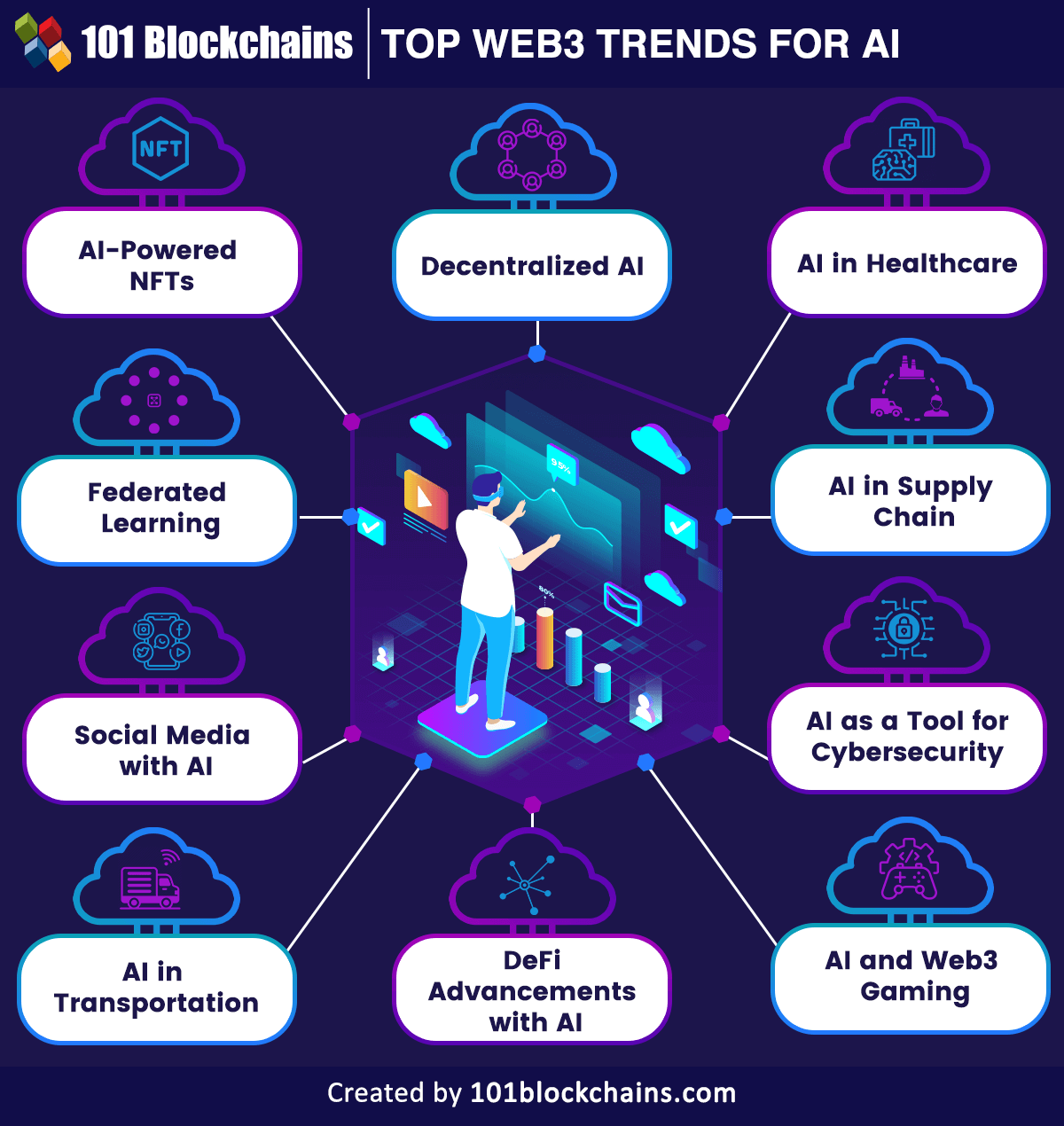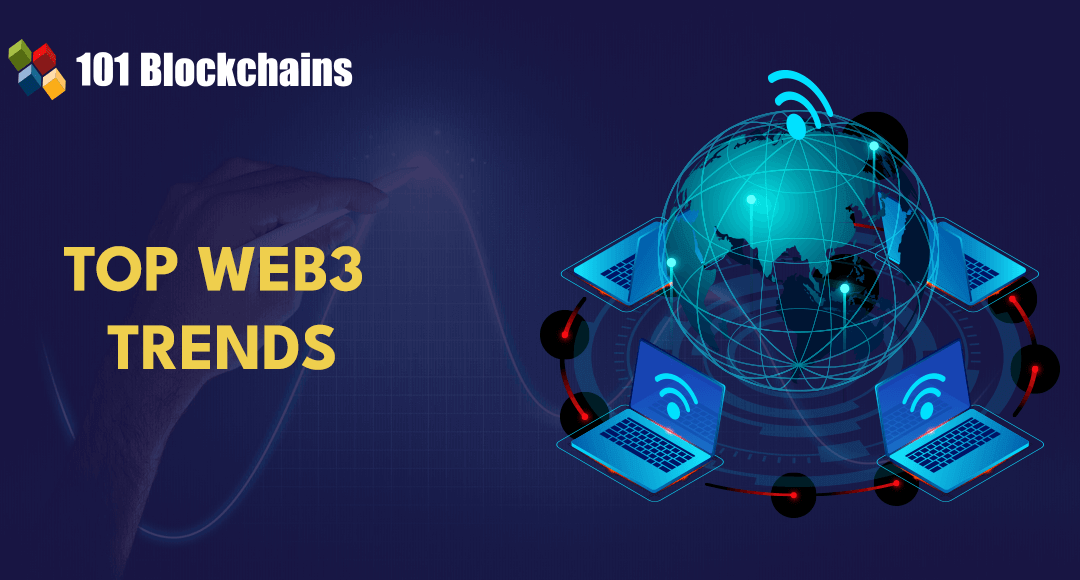The Internet has been through radical transitions over the course of time, with new variants making an indelible mark. For example, the introduction of web2 sparked the rise of social networks and new e-commerce platforms. With web2, you could not only shop and book tickets online but also share articles about events in a day of your life. However, web2 imposed the burden of monopoly by a few tech corporations.
Therefore, discussions about top web3 trends have gained the attention of everyone in the tech landscape. Web3 aims to democratize the Internet, where power would reside in the hands of users. It would utilize a combination of different technologies such as blockchain, augmented reality, virtual reality, smart contracts, and AI for creating a semantic, ubiquitous, and decentralized internet.
Blockchain and AI technology serve as the key drivers of web3 transformation. For example, blockchain provides the foundations for creating a decentralized web. On the other hand, AI could offer support for creating autonomous systems that could work on their own without intervention.
However, questions like “How AI is transforming Web3?” have paved new avenues for discussions about the impact of web3 trends on AI. Web3 and AI have the potential to transform the ways in which people interact with the Internet and each other. Let us find out the top trends in web3 that would have a major impact on the future of AI.
Understanding the Power of Web3
The discussions about the role of web3 in the future of AI should start with an in-depth understanding of the power of web3. How could it change the future of artificial intelligence, a technology which serves as a core component of web3? Web 3.0 or web3 is the next generation of the Internet, which focuses on decentralization of power and control from big tech corporations and governments. It has been developed on the foundations of web2, which dictates the existing state of the Internet featuring social media, centralized platforms, and online services.
The best web3 trends visualize the development of a decentralized web that features blockchain technology, peer-to-peer networks, and cryptography. Web3 also addresses some of the prominent setbacks associated with web2, such as censorship, uninformed access, and use of personal information and data privacy.
With the help of decentralized technologies like blockchain, web3 could offer a user-centric, secure, and more transparent internet. You can clearly notice that web3 is a game-changer in the field of digital transformation. What are the strengths of web3? You can find an effective answer in the different components of web3.
Curious to develop an in-depth understanding of web3 application architecture? Enroll now in the Web3 Application Development Course
Important Components of Web3
The next important aspect required for understanding the interplay between web3 and AI is the outline of components in web3. First of all, you must notice that Web3 Trends 2023 revolves primarily around blockchain technology, cryptocurrencies, and smart contracts. Blockchain ensures decentralization in web3 through removal of centralized intermediaries or authorities for validating or controlling data and transactions. On top of it, blockchain also ensures better security, immutability, and transparency in web3 applications.
Cryptocurrencies could facilitate peer-to-peer transactions without the need for banks. The role of cryptocurrencies in web3 draws the limelight towards possibilities for development of new economic models like DeFi. In addition, cryptocurrencies can strengthen the web3 landscape by providing independent instruments for financial exchange.
The review of the most popular web3 trends also focuses on smart contracts, which can facilitate the automatic execution of agreements and transactions upon compliance with specific conditions. Smart contracts are essential for web3 as they help in developing dApps, which would populate the web3 ecosystem. Decentralized apps could include decentralized social media platforms, prediction markets, governance systems, marketplaces, and decentralized versions of traditional applications.
Some of the other important components of web3 include decentralized identity, decentralized governance, and decentralized storage systems. Decentralized storage systems are one of the formidable future trends in web3 with the continuously growing demand for solutions like IPFS. Decentralized identity systems could offer complete control and ownership to users over their personal data.
Furthermore, decentralized governance systems could help community members participate in decision-making, thereby ensuring an active role for users in the growth of web3 platforms. All of these components of web3 have a significant influence on defining the development of AI in the future.
Learn the fundamentals, challenges, and use cases of Web3.0 blockchain from the Introduction To Web3 E-book
The Intersection between Web3 and AI
Before you ask questions like ‘What is the future trend of AI?’ you must understand how web3 and AI complement each other. Web3 and AI have the capability to enhance each other’s capabilities. Web3 could help in creating a user-centric and decentralized internet, and AI could help in creating intelligent computer systems that could learn from data and simulate human intelligence. Most important of all, web3 and AI could unlock many new possibilities alongside giving new dimensions for development to technology, society, and business. Here is an outline of the different ways in which web3 and AI could work together.
The foremost entry among the potential use cases of the combination of web3 and AI would point to decentralized AI. The decentralized infrastructure of web3 could offer the ideal environment for running AI algorithms. How will the top web3 trends define improvements in functioning of AI algorithms? AI algorithms would not have to rely on centralized cloud platforms or servers with web3.
On the contrary, web3 could ensure distribution of AI models and data across different nodes in a network. As a result, it could ensure better scalability, privacy, and security. Decentralized AI could open new prospects for better collaboration and safeguards for privacy in machine learning. The combination of web3 and AI could enable multiple participants to contribute their data for machine learning and develop new models without disclosing sensitive information.
Want to understand the importance of ethics in AI, ethical frameworks, principles, and challenges? Enroll Now in Ethics Of Artificial Intelligence (AI) Course!
The outline of Web3 Trends 2023 also emphasizes the necessity of personalization in web3. Web3 focuses on data ownership and user control, which could create the foundations for personalized AI services. At the same time, personalized AI services must be tailored to safeguard user privacy and preferences.
Web3 could help in developing AI models that utilize encrypted data or run directly on user devices. The decentralized approach to data collection ensures that users don’t have to compromise with control over personal information to obtain personalized services from AI solutions.
Data ownership and user control are the major themes in web3, which also serve as ideal examples for explaining the feasibility of combining web3 with AI. The decentralized nature of web3 could help in creating data marketplaces, which would define the future of AI with an innovative advancement. Data marketplaces could help in monetizing data through incentives for sharing data. AI algorithms could leverage the data marketplaces to access high-quality and diverse datasets for improving their performance.
-
Decentralized Governance with AI
Another promising example of blending web3 with artificial intelligence is evident in decentralized governance systems. Decentralized governance mechanisms like DAO could utilize AI technologies to improve the decision-making process. AI algorithms could support data analysis and provide access to insights alongside ensuring consensus among the community members.
The discussions about “What is the future trend of AI?” might draw references to possibilities of using AI in DAOs. Web3 expands the scope of applications of AI. For example, AI-powered DAOs could capitalize on benefits of automating specific tasks and improve efficiency. On top of it, AI could also facilitate the foundations for enabling informed decision-making without compromising on inclusion.

What are the Web3 Trends that would Shape the Future of AI?
The potential of AI for powering up digital transformation through web3 is a core precedent for web3. However, AI is not just another technology that would help you build web3. On the contrary, some of the most popular web3 trends would define radical changes in AI development. Here are the top trends in web3 that would shape the future of artificial intelligence.

1. Decentralized AI
The intersection of web3 and AI leads to the development of decentralized AI. It is a new perspective on AI utility by leveraging blockchain and other decentralized technologies. Decentralized AI can provide answers to “How AI is transforming web3?” alongside showcasing the impact of web3 trends on AI. It would help in creating AI systems that are under the ownership and control of the community. Decentralized AI could resolve many concerns with centralized AI, including bias, security, and privacy.
2. AI-Powered NFTs
Non-fungible tokens, or NFTs, are a specific variant of digital assets that have gained massive popularity in the web3 ecosystem. NFTs are unique digital assets stored on blockchain networks, which could represent every asset, including real estate and digital artworks. Artificial intelligence could serve as a powerful tool for creating new opportunities to use NFTs. For example, AI-powered NFTs could support use cases for verification of product authenticity and creation of personalized experiences.
Want to get an in-depth understanding of non-fungible tokens (NFTs)? Enroll now in the NFT Fundamentals Course.
3. Federated Learning
The next addition among the future trends in web3 that would influence AI refers to federated learning. It is a new approach to machine learning in which AI models would be trained using data from user devices. Federated learning could help in addressing the concerns regarding privacy with centralized AI.
4. Social Media with AI
Artificial intelligence has a major role in transforming social media networks. AI could help in creating more personalized experiences by capitalizing on the top web3 trends such as data ownership and control. AI could emerge as a critical tool for decentralized social media networks with functionalities for moderating conversations and removing harmful content.
5. DeFi Advancements with AI
The applications of artificial intelligence would also discover new directions with the rise of web3 trends 2023 in the domain of DeFi. DeFi, or decentralized finance, offers a new model for financial systems developed on the foundations of decentralized technologies. Artificial intelligence could help in creating new DeFi applications for trading assets or lending and borrowing.
Want to know more about DeFi? Enroll Now in Introduction to DeFi Course
6. AI as a Tool for Cybersecurity
Web3 can capitalize on the capabilities of AI for detecting patterns and anomalies to facilitate improvements in cybersecurity. Therefore, artificial intelligence could emerge as a new contender in the domain of cybersecurity by detecting and preventing attacks proactively. The future of AI with web3 could introduce highly responsive mechanisms for monitoring threats and responding to incidents.
7. AI in Supply Chain
The combination of web3 and AI emphasizes the element of transparency. Web3 could determine the future of artificial intelligence by providing opportunities for implementing AI in supply chain management. For example, AI could serve a crucial role in optimization of inventory management, preventing fraud, and tracking shipments.
Excited to learn the fundamentals of AI applications in business? Enroll Now in AI For Business Course!
8. AI in Healthcare
The outline of best web3 trends would also draw attention to the applications of web3 in healthcare. Artificial intelligence could have a revolutionary impact on healthcare sector in future. As of now, the use cases of AI in clinical research and drug development provide a clear impression of the future of artificial intelligence in healthcare. AI could help in efficient and faster diagnosis, providing personalized healthcare services, and developing new approaches for treatment.
9. AI in Transportation
The applications of AI in the transportation sector would leverage decentralization in web3 to introduce massive value-based improvements. For example, most popular web3 trends like decentralization could help in creating systems that use AI for developing self-driving cars. In addition, web3 trends could empower AI systems for optimization of traffic flow and improving public transportation systems.
10. AI and Web3 Gaming
The prominent growth of web3 trends, such as metaverse and web3 gaming, also provide opportunities for incorporating AI. Web3 could define the future course of AI in the gaming industry with credible value advantages. AI could help in development of more realistic and immersive games alongside ensuring proactive detection of cheating. Most important of all, AI systems could also ensure personalization of gaming experiences.
Build your fluency in Web3 and develop decentralized solutions with the world’s first Web3 Expert Career Path with quality resources tailored by industry experts Now!
Final Words
The review of the top web3 trends and their impact on AI shows that the combination of web3 and AI could create new benchmarks in digital transformation. Web3 emphasizes notable trends such as decentralization, use of cryptocurrencies, NFTs, and smart contracts. On the other hand, AI helps in simulation of human intelligence in computers. With a combination of web3 and AI, you can find prospects for transformation of AI itself.
Web3 would open the scope for different use cases of AI. For example, AI could help in defining the designs of future metaverse and web3 games. In addition, AI could also serve as a critical component of decentralized systems for monitoring supply chains, transportation fleets, or healthcare systems. Explore the endless opportunities for capitalizing on the power of AI now.

*Disclaimer: The article should not be taken as, and is not intended to provide any investment advice. Claims made in this article do not constitute investment advice and should not be taken as such. 101 Blockchains shall not be responsible for any loss sustained by any person who relies on this article. Do your own research!








